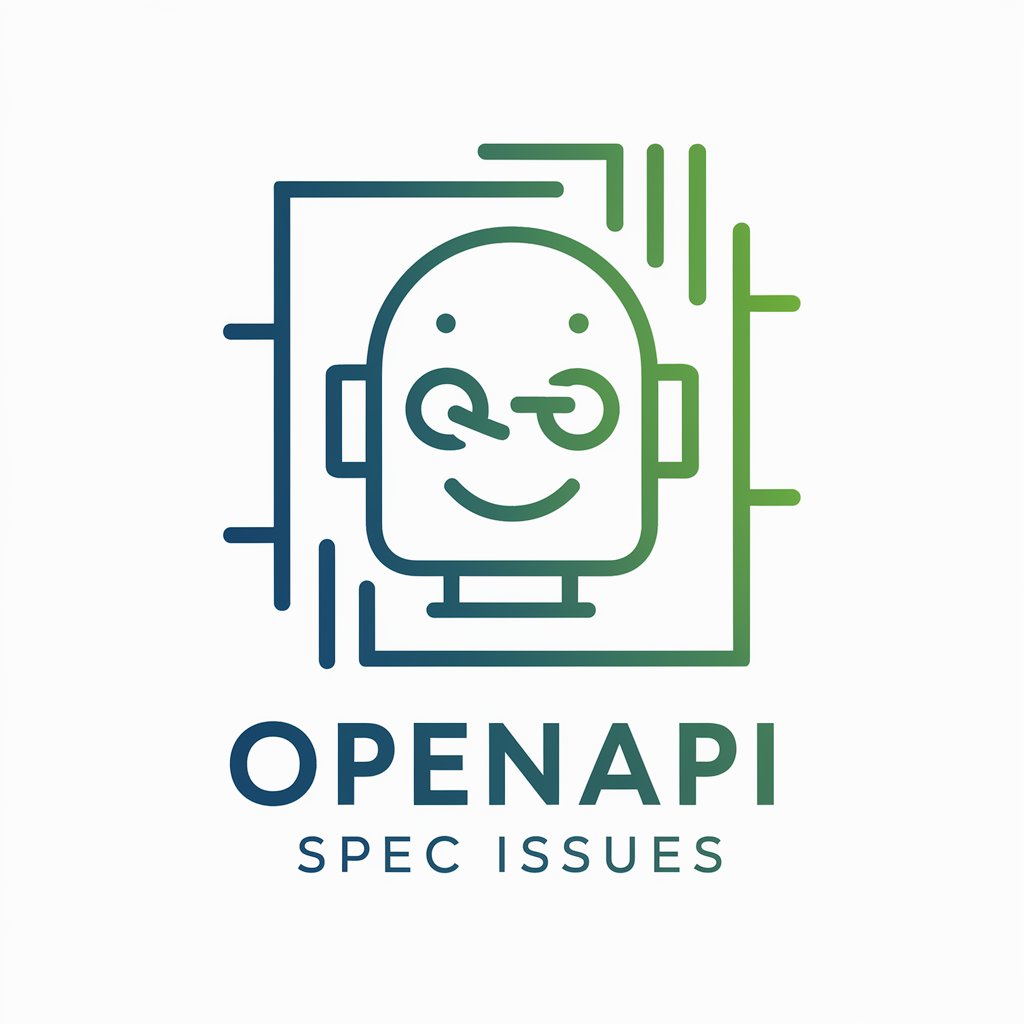
OpenAPI spec issues - OpenAPI Specification Aid

Welcome! Let's solve your OpenAPI spec issues together.
Streamlining API Development with AI
How can I resolve an error in my OpenAPI specification that says...
What tools can I use to validate my OpenAPI document for...
Can you help me understand the difference between 'paths' and 'components' in OpenAPI?
What are some best practices for maintaining a robust OpenAPI specification?
Get Embed Code
Introduction to OpenAPI Spec Issues
OpenAPI Spec Issues revolve around the common challenges and errors encountered when designing, implementing, or interpreting OpenAPI Specifications (OAS). The OpenAPI Specification, formerly known as Swagger, provides a standard, language-agnostic interface to RESTful APIs. This allows both humans and computers to discover and understand the capabilities of a service without access to its source code or documentation. Issues can range from syntax errors, incorrect schema definitions, to more nuanced problems like poorly defined authentication requirements or inconsistent parameter descriptions. For example, a developer might encounter an issue where the API's response schema does not match the actual payload returned by the API, leading to client-side integration problems. Another scenario could involve discrepancies in parameter definitions, such as required fields being marked as optional, causing confusion about the API's usage. Powered by ChatGPT-4o。

Main Functions of OpenAPI Spec Issues
Syntax Validation
Example
Using a tool like Swagger Editor to identify and correct syntax errors in an OpenAPI document.
Scenario
A developer writes an OpenAPI spec for a new API but mistakenly uses an incorrect data type for a response object. Syntax validation can highlight this mistake, allowing the developer to correct the error before it affects API consumers.
Schema Validation
Example
Employing tools such as Spectral to enforce best practices and consistency in API design.
Scenario
An organization maintains several APIs, each designed by different teams. Schema validation ensures that all APIs adhere to a consistent structure and naming convention, facilitating easier integration and comprehension across teams.
Documentation Generation
Example
Using Redoc or Swagger UI to generate human-readable documentation from an OpenAPI specification.
Scenario
After finalizing an API's specification, a team uses documentation generation tools to automatically create an interactive API documentation portal. This allows developers and external users to easily understand and try out the API's endpoints without digging through raw specification files.
Mock Server Generation
Example
Utilizing tools like Prism to create mock servers based on an OpenAPI specification.
Scenario
While the backend development is still in progress, a front-end team generates a mock server from the API's OpenAPI spec. This enables the front-end team to begin integrating and testing the API's endpoints without waiting for the backend implementation to be completed.
Ideal Users of OpenAPI Spec Issues Services
API Developers
Developers designing or implementing RESTful APIs will find OpenAPI spec issues services invaluable for validating syntax, ensuring schema consistency, and generating documentation. These tools help in identifying and rectifying common pitfalls in API design, making the development process smoother and more efficient.
API Consumers
Developers or organizations that consume third-party APIs can use OpenAPI spec issues services to better understand the APIs they integrate with. Tools that generate documentation or mock servers from an OpenAPI spec can significantly reduce integration time and help in debugging integration issues.
Technical Writers
Technical writers tasked with documenting APIs benefit greatly from OpenAPI spec issues services, particularly automated documentation generation. This allows for the creation of accurate, up-to-date API documentation, enhancing the usability and adoption of the API among developers.

Using OpenAPI Spec Issues: A Step-by-Step Guide
Step 1
Start by visiting yeschat.ai for a complimentary trial, accessible immediately without any login requirement or the need for ChatGPT Plus.
Step 2
Familiarize yourself with the OpenAPI Specification (OAS) by reviewing its documentation. Understanding the structure and syntax of OAS is crucial for effective usage.
Step 3
Identify the specific aspect of your API that you need help with. This could range from schema definitions to response object structures.
Step 4
Use OpenAPI Spec Issues to validate your API document. This tool helps in identifying and resolving issues related to your API’s OpenAPI specification.
Step 5
Leverage community support. Engage with forums or user groups for additional insights and best practices in using OpenAPI Spec Issues effectively.
Try other advanced and practical GPTs
Rescue AI
AI for Emergency Insight and Action

网站营销助手
Empower Your E-commerce with AI-driven Marketing

"तत्पर अभियंता"
Empower your creativity and productivity with AI.

Playbook Pré-Vendas YUNGAS
Empowering Pre-Sales with AI Insights

Morse Translator GPT
Translate Morse code seamlessly with AI.

Visual Muse
Ignite Your Creativity with AI

Guide Literie Bot
AI-Powered Bedding Recommendations at Your Fingertips

AI reader for Traditional Chinese users
Empowering Traditional Chinese comprehension with AI

Külsős Szövegíró
Elevate Your Writing with AI

GPT LEICHTE SPRACHE (deutsch)
Simplifying texts with AI-powered precision

HACCP Consulting & Food Safety
Streamlining Food Safety with AI

LinguaBuddy
Master Spanish with AI-Powered Conversations

Frequently Asked Questions about OpenAPI Spec Issues
What is OpenAPI Spec Issues primarily used for?
OpenAPI Spec Issues is primarily used for validating and troubleshooting issues in API documents that adhere to the OpenAPI Specification.
How can I resolve validation errors in my OpenAPI document?
To resolve validation errors, carefully review the error messages provided by OpenAPI Spec Issues, ensure your API document adheres to the OpenAPI Specification, and make the necessary corrections.
Can OpenAPI Spec Issues assist in improving API design?
Yes, by identifying inconsistencies and errors in your OpenAPI document, this tool can indirectly aid in refining your API's design and structure.
Is OpenAPI Spec Issues suitable for beginners?
Yes, while a basic understanding of API and OpenAPI Specification is beneficial, the tool is designed to be user-friendly and accessible to beginners.
Can this tool help with API security?
While OpenAPI Spec Issues focuses on specification compliance, adhering to a correct specification can indirectly improve the security aspects of an API by ensuring structured and well-defined requests and responses.